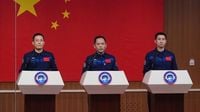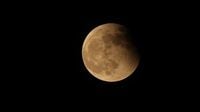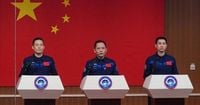China is pushing full steam ahead with its ambitious plans to put astronauts on the Moon before the decade is out, reaffirming its commitment to a crewed lunar landing by 2030. At a press conference held on October 30, 2025, at the Jiuquan Satellite Launch Center, Zhang Jingbo, spokesperson for China’s Manned Space Program, made it clear that the country’s lunar aspirations are not just talk—they’re backed by significant progress and a flurry of activity.
“Currently, each program of the research and development work of putting a person on the moon is progressing smoothly,” Zhang told reporters, as cited by the Associated Press. He highlighted ongoing work on the Long March 10 rocket, moon landing suits, and the lunar exploration vehicle as major milestones. “Our fixed goal of China landing a person on the moon by 2030 is firm.”
This steadfastness comes as China prepares to launch its latest crew to the Tiangong space station—the next step in a broader campaign to establish itself as a leader in space exploration. The upcoming Shenzhou-21 mission, set to blast off at 11:44 p.m. local time on October 31, 2025, will carry three astronauts: veteran Zhang Lu, and first-timers Wu Fei and Zhang Hongzhang. Notably, Wu Fei, at just 32 years old, will become the youngest Chinese astronaut to fly into space so far, according to the China Manned Space Agency (CMSA).
This new crew is expected to spend six months aboard Tiangong, conducting a range of scientific experiments and system maintenance. Among the cargo for this mission: four lab mice—two male and two female—which will be used in China’s first in-orbit rodent experiments to study the effects of weightlessness and confinement on living organisms. As Zhang Jingbo explained, “They will study the effects of weightlessness and confinement on the animals.”
The Tiangong space station, also known as the “Heavenly Palace,” stands as the crown jewel of China’s space program. It was conceived and built after China was excluded from the International Space Station (ISS) due to U.S. national security concerns over the Chinese program’s direct ties to the People’s Liberation Army. According to The Express, “China initiated construction on the Tiangong, or ‘Heavenly Palace,’ after being barred from the International Space Station due to U.S. national security worries about the Chinese space program’s direct ties to the People’s Liberation Army.”
But China’s ambitions reach far beyond low-Earth orbit. The CMSA has mapped out a packed schedule of development and testing for its crewed lunar program. Upcoming and ongoing tests include integrated testing for the Lanyue lunar lander, thermal tests and maximum dynamic pressure escape tests for the Mengzhou manned spacecraft, and low-altitude and technology verification flights for the Long March-10 rocket. “The research and development projects for our manned lunar mission are advancing steadily,” Zhang Jingbo emphasized, as quoted by AP.
According to ECNS, the Mengzhou-1 spacecraft is designed not only to support the lunar exploration mission but also to operate alongside the near-Earth space station. The spacecraft’s mission logo will be unveiled next year as part of a public solicitation campaign. The project team has already completed primary prototyping of key flight hardware, including the Long March-10 rocket, Mengzhou spacecraft, Lanyue lander, Wangyu lunar extravehicular suit, and the Tansuo crewed lunar rover. Payload designs for scientific research and applications are finalized, and work on ground infrastructure—including launch sites, tracking networks, and landing sites on Earth—is accelerating.
2025 has seen a string of successful tests: the second-stage propulsion system test and captive firing test for the Long March-10 rocket, the zero-altitude escape test for the Mengzhou spacecraft, and comprehensive landing and takeoff verification for the Lanyue lander. These are no small feats. Yet, as Zhang Jingbo acknowledged, “the project team still faces risks and challenges, including heavy workload, high quality standards, and tightly scheduled flight tests.” He pledged that the team would “ensure the successful completion of all development tasks and lay a solid foundation for realizing the crewed lunar landing mission as planned.”
China’s lunar plans aren’t just about national pride—they’re also about international collaboration. In a move that signals a new era of cooperation, China has reserved a spot for a Pakistani astronaut on one of its short-duration spaceflight missions. Two Pakistani astronauts will train with their Chinese counterparts, with one ultimately selected to fly as a payload specialist. This marks a significant step for Pakistan’s space ambitions and reflects China’s growing willingness to include international partners in its space endeavors, as reported by The Express.
Meanwhile, the Shenzhou-21 mission is a powerful symbol of China’s evolving space capabilities. Zhang Lu, the mission commander, is a veteran of the Shenzhou-15 mission, while his crewmates Wu Fei and Zhang Hongzhang are making their inaugural flights. The mission’s scientific component, particularly the rodent experiments, is expected to yield valuable insights into how prolonged exposure to microgravity and isolation affects mammals—findings that could inform future long-duration missions to the Moon and beyond.
China’s investment in space has been massive. Billions of dollars have poured into the program as the country seeks to catch up with, and perhaps even surpass, the United States and Russia. The exclusion from the ISS has only fueled China’s determination to go it alone—and, in some respects, to go further. As The Express notes, “The Tiangong space station… is the crown jewel of China’s space programme. The country has invested billions of dollars in it in an effort to catch up with the United States and Russia, following its exclusion from the International Space Station due to US national security concerns.”
Looking ahead, China’s lunar ambitions are set to culminate in the construction of a base on the Moon’s surface. The Mengzhou-1 spacecraft will play a pivotal role in this endeavor, supporting both lunar missions and operations in low-Earth orbit. The project team is keenly aware of the heavy workload and high standards required, but the sense of momentum is unmistakable. As Zhang Jingbo summed it up: “Our target of landing Chinese astronauts on the Moon by 2030 remains on path.”
With each successful mission, test, and international partnership, China is steadily transforming itself into a powerhouse of space exploration. The next few years promise to be a fascinating chapter—not just for China, but for humanity’s quest to reach farther into the cosmos.


